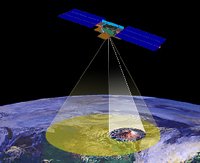Since the dawn of the space age, unmanned spacecraft have flown
blind, with little or no ability to make decisions without
humans continuously directing them. Many of these missions are guided
and controlled by ground crews——from a long distance
away——using delayed commands. The spacecraft are not able
to react quickly to these long distance, delayed commands. All this
will change in a few years!
Some of these changes will be made by the New Millennium Program's (NMP) Space Technology
6 (ST6) Project. ST6 has developed two advanced, experimental
technologies for use on spacecraft of the future. These technologies,
the Autonomous Sciencecraft Experiment and the Inertial Stellar Compass, will improve a spacecraft's ability to:
- make intelligent decisions on what information to gather
and what to send back to the ground
- determine its own attitude and adjust its pointing (where
it is aimed)
All without help from humans!
The common goal of the two technologies is to free the spacecraft from its continuous link with the ground and shift the decision making to the spacecraft
itself. With their many "firsts," each technology is flight tested in the harsh
environment beyond Earth to validate performance prior to use on expensive, actual space exploration missions.
 |
Artist's concept of
Sciencecraft
technology.
|
The Autonomous Sciencecraft Experiment, referred to here as
Sciencecraft, allows a spacecraft to perform several tasks that
have never been done before. Sciencecraft processes data onboard,
sends data back to Earth that the craft decides are scientifically important,
and chooses to make science observations that appear
interesting——autonomously (all by itself). This technology involves feature and change detection, continuous planning technology, and robust execution. It is equipped with software that checks spacecraft performance and has resources to prevent errors.
Sciencecraft was beamed onboard the New Millennium Program's in-flight Earth Observer 1 early in 2004. Since that time, the Sciencecraft team have steadily increased the level of autonomy during the validation period, conducting numerous experiments with over 100 autonomously planned image data takes. Jet Propulsion Laboratory (JPL) is the technology provider. In addition to JPL, the Sciencecraft team includes Goddard Space Flight Center, the University of Arizona, Arizona State University, and Interface Control Systems.
 |
Artist's concept of
Compass
technology.
|
The Inertial Stellar Compass, referred to here as Compass,
enables a spacecraft to continuously determine its attitude or the
direction in which it is pointing. It also enables a spacecraft
to recover its orientation (direction and pointing) after a temporary
malfunction or power loss. This is done by the "marriage" of a
miniaturized star camera and gyro system. Although this is not a new
concept, the small size and low power consumption are revolutionary
and an important feature for the new, smaller spacecraft and
satellites of the future.
Compass technology uses an active pixel sensor in a star-tracking
camera and a three-axis system of microelectromechanical gyros.
Draper Laboratory is the technology provider. Compass is flying
on the TacSat-2 satellite, launched in December 16, 2006.
TacSat-2 is a joint project of the Air Force Research Laboratory (AFRL), the DoD Space Test Program, (Space and Missile Systems Center’s Space Development and Test Wing), the Naval Research Laboratory, the Army Space Program Office, Air Force Space Command and the Space Warfare Center.
The technologies of ST6 will revolutionize future NASA spacecraft and
allow mission resources to focus on science goals. They will reduce
current human intervention in spaceflight missions of the
21st century. Flying "blind" will be a thing of the
past.